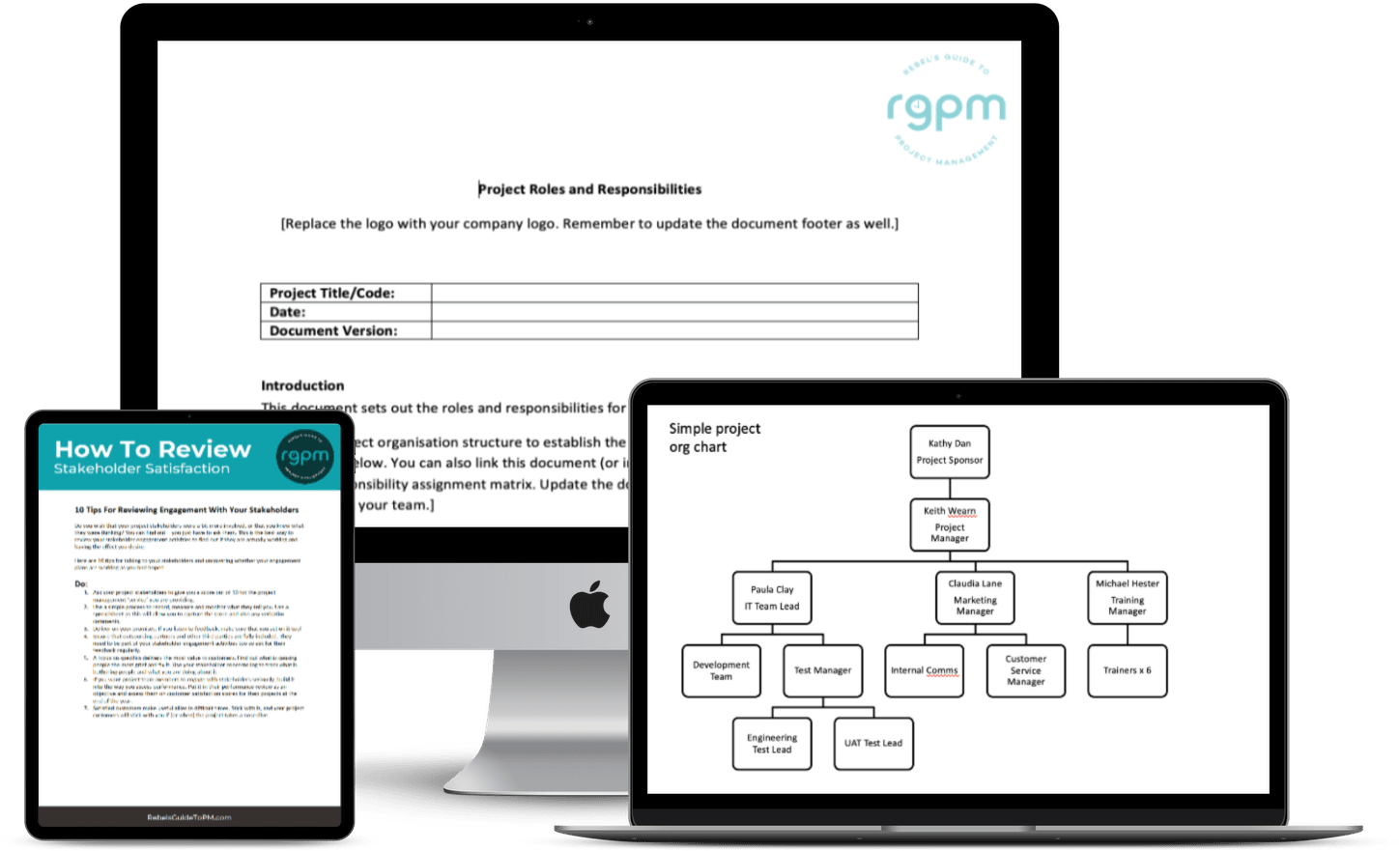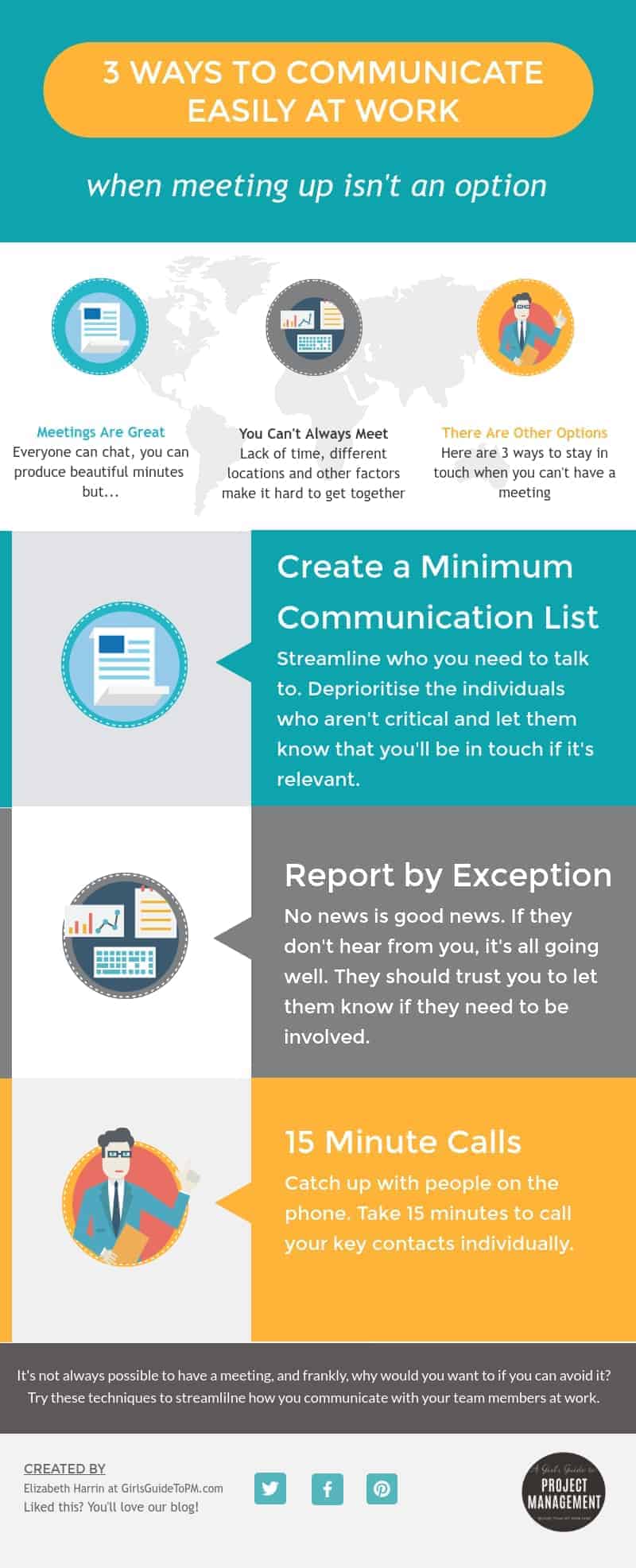How To Communicate Effectively When You’ve Got No Time For Meetings
“How can I manage my stakeholders when there isn’t enough time for meetings?” a project manager asked me recently. She had ruled out emails and wanted another option for communicating (preferably asynchronous) that wouldn’t involve sitting in project meetings.
I had a couple of options for how to communicate effectively with her team that I shared with her, and today I’ll share them with you.
If, like so many people, you are struggling to find ways to get the word out when you can’t get everyone to a meeting, these might help you too.
Here are 6 ways to communicate when you don’t have time for a meeting:
- Create a minimum communication list
- Establish the minimum communication you can do
- Phone the difficult stakeholders
- Make email updates better
- Try ditching real-time comms
- Report by exception.
Let’s dive into each of these and see how they could work for you.
1. Create a minimum communication list
Who is in the minimum group of stakeholders you have to communicate with? Make a list of all your stakeholders. Identify the ones that aren’t that important to your projects’ success, then drop them a quick message saying you are happy to update them whenever and they just need to get in touch with you.
Then cross them off and stop contacting them (or at least contact them infrequently, maybe about major stuff).
If they are that bothered about knowing what is going on, they will get back in touch. Obviously don’t do this with people who are critical and who need to have the information!
Talk to the people left on the list – what do they want to know? How do they want to know it? Most reasonable people will recognize that they can’t say they want to hear about the project, refuse to engage and then complain that they don’t know anything.
2. Establish the minimum communication you can do
What is the minimum amount of communication you could get away with? Perhaps:
- Making sure people have the data they need for decision making on the project
- Making sure the sponsor/key stakeholders are aware of issues that you need support with
- Making sure they know what decisions you need them to make so you can move the project forward.
Map your ‘minimum communication list’ to the relevant people and forms of communication and use that as the basis for the project communications plan (get a free template for a comms plan here).
3. Phone the challenging stakeholders
I know, I know: there is no such thing as a difficult stakeholder, only challenging behavior. When you know who is going to display challenging behavior, you can separate them out for special attention.
If you don’t have time for dedicated stakeholder meetings, don’t have meetings.
You already know the stakeholders who behave in a difficult way. When you can’t predict how they will react, it’s actually easier to talk to them one to one. (Here are more strategies for engaging with and managing difficult behavior in stakeholders.)
Find time to speak to the stakeholders individually – 15 minutes per important person is enough, so give them a ring.

4. Make email status updates better
Emails don’t have to be a black hole. In my experience emails get read if they are short, targeted and people know what they are before they open then.
I am personally a big fan of email status updates. I cover:
- Tasks completed this week:
- Tasks due for completion next week:
- Other things of interest:
I don’t bother to include ‘Dear…’ at the top (only for these status updates!) and just end it with my normal email signature. I color code the status updates Red, Amber, Green to make it even easier for the lazier readers. You could tweak the format to suit you. If people aren’t interested they won’t open the message; if they are, they will.
It does depend on your audience. Email is definitely how to communicate effectively with me — I often have my phone on silent and don’t even check it until the end of the day — but that isn’t the case for many of my stakeholders.
5. Try ditching real time comms
Asynchronous communication is when the message is given and received at different times, for example if you record a webinar and then participants play it back later.
The trouble with asynchronous communication is that you can’t force people to engage with those methods and you’ll never really know if they have received the message.
If you want to give it a go you could try:
- A newsletter (lots of work for you, they probably still won’t read it)
- A monthly report (maybe in presentation format instead of a document – key points on a slide)
- The dashboard functionality of your project management software. You could set up a dashboard and give them access and let them look at it when they have time (they probably would never look)
6. Report by exception
One way to communicate effectively, especially if you have zero time in the day for niceties is to agree that you’ll only report to certain stakeholders by exception.
Tell them to assume it is all going well and you have it under control unless they hear otherwise. Then they will know that communication from you requires some action on their part (you can also put ‘Action Required: xxx’ in the subject line of emails).
Of course, you may find after all this reflection and effort that people actually don’t mind much about hearing regular updates.
How do you manage communications with stakeholders who are too busy? Email me your ideas or leave a comment in our community Facebook group, and I’ll compile the responses for a future article. Thanks!

